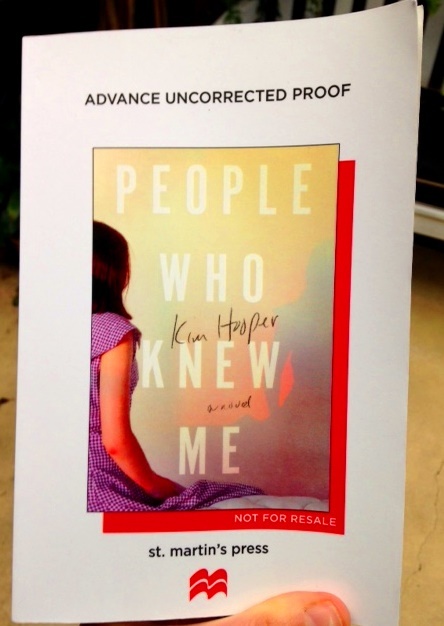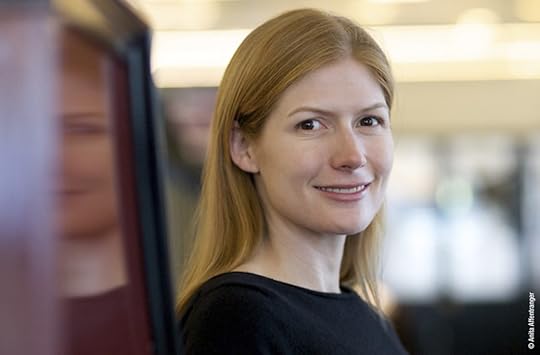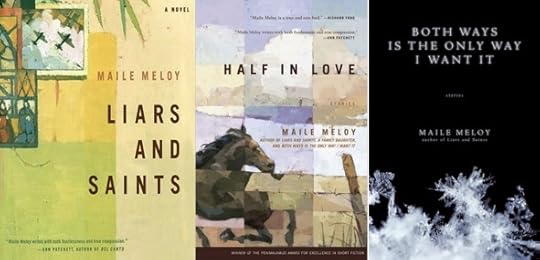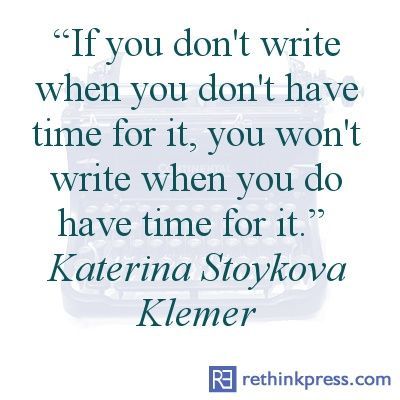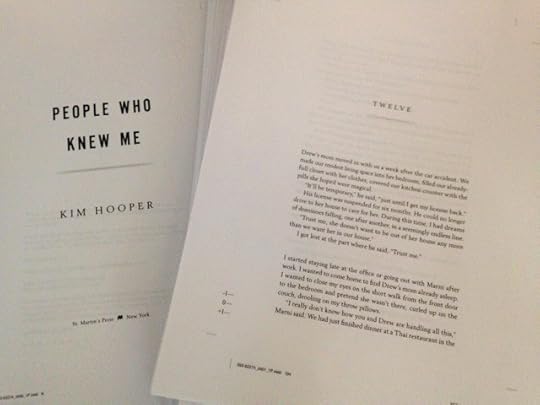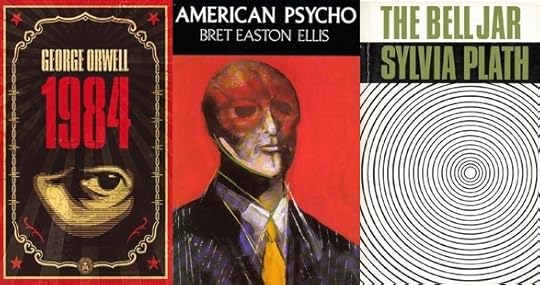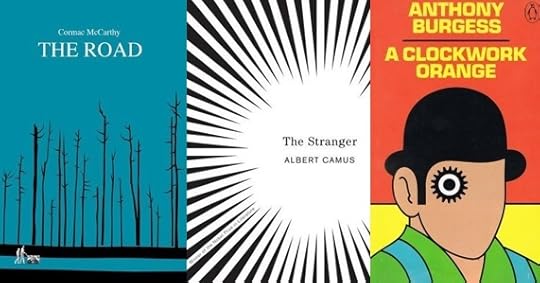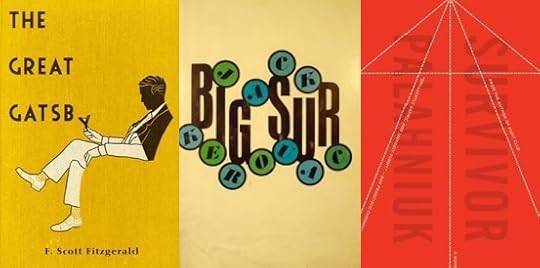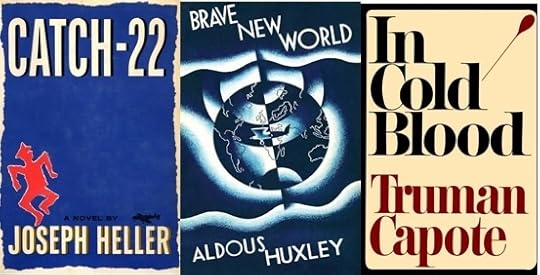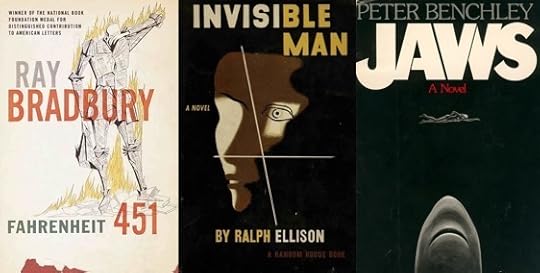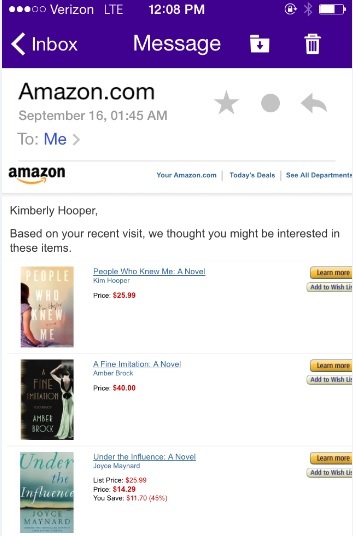Kim Hooper's Blog, page 38
December 12, 2015
Publishing Journey: The galleys are here!
They’re here, they’re here! Christmas came early.
If you’re wondering what the heck a galley is, let me explain. Book galleys (aka “bound galleys”) are the manuscript after it has been copyedited and typeset. It’s definitely not the final copy of the book. As you can see, the cover is not final. And my book will be hardcover (galleys are paperback).
Galleys are put together for several reasons. They’re given to the publishing house’s sales reps, to pass on to their accounts. They’re given to reviewers, who then give quotes that go on the final book jacket. They’ve given to magazine editors to solicit reviews. They’re basically for advance publicity. As the author, I got 5 for myself. I don’t really know what to do with them. I put them on my dresser. I stare at them when I wake up and go to bed. That’s about it.
Fun fact: Because galley copies of a book are somewhat rare (there aren’t that many printed), they can end up being worth a lot of money later. The bound galley of Harper Lee’s To Kill a Mockingbird sold for more money than the first edition of the book!
My publication date is about 5 months away now. Getting closer. Those galleys on my dresser are just one more thing to convince me it’s really happening.
The post Publishing Journey: The galleys are here! appeared first on Fiction Writing Blog.
November 27, 2015
Spotlight on: Maile Meloy
If you don’t know Maile Meloy yet, you’re missing out. For whatever reason, I didn’t discover her writing until last year. I’ve now read 3 of her works: Liars and Saints (novel), Half in Love (short story collection), and Both Ways is the Only Way I Want It (short story collection). There is something so simple, yet complex, about her writing. Powerful subtlety, that’s what it is. Whenever I find an author I love, I scour the Internet for insights into their writing process and what makes them great. Here’s some of what I found about Maile Meloy.
On how writing short stories influences her novels, and vice versa:
“Having written two novels might be the reason the stories are a little longer now. But I think that writing short stories has affected the novels more: both novels have slightly story-like chapters, and I think writing short stories trains you to a kind of efficiency, because everything needs to count.” (Source)
On what she prefers to write–novels or short stories:
“I like going back and forth between the two. It’s like the difference between a long marriage and dating, and there are advantages to each. With a novel, you know you have the book there to work on every morning. With stories, you have new characters and fresh situations. (Although some of my stories have taken me as long as the novels, as I’ve put them aside and picked them up again.) Some of the stories in Both Ways Is the Only Way I Want It were written (or started) before and between the novels, and some after.” (Source)
“I think 10-15 pages is sort of my natural length, in the way a runner might run the 800- or the 100-meter dash. Short stories are harder because you have to start over every time, with new characters and new situations, but they’re what I did first. And you can see the end of them. I like living in a novel, as a writer and as a reader, but sometimes you can’t see your way out.” (Source)
On first drafts:
“They’re spare. I often start with not that much more than dialogue. Then I have to go back and put in details about what things look like and where everyone is and what they’re wearing. What happens between people is the most interesting thing to me. I have to make sure that readers can see the scene, and feel it, but I don’t really care what the trees look like. I can make myself care if the trees are really important.” (Source)
On how her stories begin:
“They almost always begin with a scene or a situation, often very small, always involving at least two people. But the stories don’t go unless I have the voice. It’s like a getting into a car with a tricky clutch, and you can either get it in gear or you can’t. I think the voice has a lot to do with whether I can get the story in gear and make it go.” (Source)
On struggling with titles:
“I’m very slow about titles, and I welcome suggestions from people who’ve read early drafts. Sarah, my editor, usually comes up with a very long list—I don’t know how she does it.” (Source)
On writing from the male point of view:
“I didn’t realize there were so many male protagonists until I put all the stories together. I think part of the reason I like a male perspective is that it gets me out of myself.” (Source)
On (not) outlining:
“I wish I could. It might be more efficient. I figure the story out as I go along, and then revise heavily when I know what it is. The story “O Tannenbaum,” in Both Ways Is the Only Way I Want It, started with the idea of a family out cutting down a Christmas tree, and choosing one that’s crowding another tree, so that the tree left behind would have room to grow. We used to do that, when I was growing up in Montana, and it seemed like a promising idea, but I didn’t have anything more in mind than that. The hitchhikers showed up for me as they do in the story, under a tree in the snow. And then I have to figure out what to do with them, why they’re there.” (Source)
On figuring it out as she goes:
“I develop everything as I go and figure out the characters as I write the story. Who they are is inseparable from what they do and how they respond to what happens. Sometimes things occur to me when I’m taking a walk or doing something else, but mostly I work it out on the page.” (Source)
On rules for creating characters:
“One [is] that you can’t have your characters get everything they want at the end, and another [is] that they can’t be perfectly bad or perfectly good.” (Source)
On writing YA (Apothecary):
“I don’t know what will happen when I try to write another novel for adults, but I think the YA books have given my plot-designing muscles a workout. As Roald Dahl said of writing for kids, “They lose interest so quickly. You have to keep things ticking along.” (Source)
On her ideal workspace:
“I have a chair that tilts back like an astronaut chair, and a desk that comes over on an arm, with a laptop on it. I started using that set-up because it was easier on my shoulders to be in the tilted-back position, but now I can’t compose anything beyond an email if I’m sitting up straight. Sideways on a couch with a lap desk works in a pinch.” (Source)
On advice she would offer aspiring writers:
“Set aside time to write, even if it’s only an hour or two a day, and think of the time as the requirement. So you just have to be there, and it doesn’t matter what you finish. It takes the pressure off the individual story or chapter, and you’ll end up working on the ideas that seem most promising. I start many, many stories and abandon most of them, but eventually some pay off.” (Source)
“Read all you can. Anyone who writes dialogue is probably a natural mimic, so I think it’s good to read as many different kinds of writers as you can, on your way to finding your own voice. You couldn’t possibly mimic all of them, but you can see what other people do. Also write all you can. It’s like playing an instrument, and you have to practice, and the way you practice writing is to write stories and throw many of them away. Also pay attention to the world, to the stories people tell you, to how they do the things they do all day.” (Source)
“Write all you can: essays, stories, poems, whatever. Don’t worry about whether it’s good while you’re writing it, just keep going. Then let some time pass and go back to read it over, and you’ll see things you want to fix. Time is the great editor.” (Source)
On feedback from readers:
“I hear from people a lot, even though I’m not on Facebook and don’t tweet and don’t have a blog. I do think it’s much more possible to be in touch than it used to be, but I’m not sure that’s important to the work itself. You don’t want to be too eager to please, or too afraid of criticism. For publishing reasons, it took two years for my first story collection to come out, after I sold it, and I wrote my first novel in the meantime.
I like hearing from readers now, but I’m really glad I had that protected space for two books and not just one. I think it was good to keep writing on my own, without any expectations or opinions coming in.” (Source)
Fun facts:
She was born and raised in Helena, Montana in the early 1970s
Her name is pronounced MY-lee. It’s Hawaiian
While studying at Harvard, she took a fiction class with Richard Ford. He saw her talent and encouraged her to study at the University of California, Irvine with his good friend, Geoffrey Wolff
Meloy had an agent before she even finished her time at UC Irvine. And not just any agent, but super-agent Amanda “Binky” Urban
The post Spotlight on: Maile Meloy appeared first on Fiction Writing Blog.
November 24, 2015
The unknown: Writing when you have no idea what you’re doing
I spent most of this past weekend thinking about my second novel. My plan is to submit synopses and sample chapters for a few novels I’ve written over the last several years, along with some new ideas, to my agent and publisher in the near-ish future. When I created this plan, it sounded reasonable, but I’m having so much anxiety about it. Most of my anxiety is about the new ideas because they are just that–ideas. They are not at all fleshed out. If the consensus is that one of my ideas has the strongest potential for a second novel, then I will have to write the damn thing. And I have no idea what the meat of those stories will be. It’s like walking into a big unknown.
But then I got to thinking that every story I write is walking into a big unknown. It’s just that I usually meander into the unknown in a much more leisurely manner because, until now, nobody has been waiting for my work. I think the trick is to work the same way I always have, as if nobody is watching or waiting. And I have to remember that what I’ve always loved about writing is that big unknown.

I read Ann Patchett’s This is a Story of a Happy Marriage a little while ago and she had some great things to say about her writing life (and the unknown). She says:
“There are people who write in order to find out where the story goes. They never talk about what they’re working on. They say if they knew the ending of the book there would be no point in writing it, that the story would then be dead to them.
“There are also people…who map out everything in advance. (John Irving, for example, can’t start writing his books until he thinks up the last sentence.)”
I am definitely in the first camp. Always have been. Every novel I’ve written has started with very vague intentions. And they always take turns I never could have predicted (and wouldn’t want to). So, why am I afraid of the unknown? Maybe I’m just afraid of the work ahead. I know it takes time to wander through the unknown, to figure out the characters and where they’re going. Lots of time.
Later, Patchett says about the early stages of writing a novel:
“It’s like walking through a field in a snowstorm and for a long time I see nothing but the snow, but then in the distance there’s something, a tree or a figure or smoke, I just don’t know. I always have the sensation that I’m straining to see what’s in front of me. The snow lessens for a minute and I catch a glimpse of an idea, but when I get closer the light starts to fade. I squint constantly. It goes on like this for a long time. If I were taking notes they would read: I see something. A shape? I have no idea. It’s not exactly the stuff that literary archives are made of.”
Reminds me of one of my favorite quotes (which I think applies to writing and living life in general):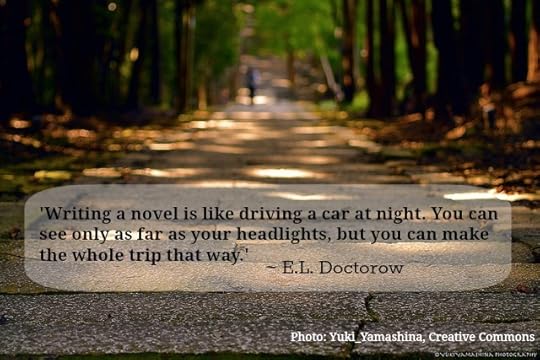
Patchett says, ultimately, the unknown is a good thing:
“What I like about the job of being a novelist, and at the same time what I find so exhausting about it, is that it’s the closest thing to being God you’re ever going to get. All the decisions are yours. You decide when the sun comes up. You decide who gets to fall in love and who gets hit by a car. You have to make all the trees and all the leaves and then sew the leaves onto the trees. You make the entire world.”
Right. I make the entire world. No big deal. I got this.
The post The unknown: Writing when you have no idea what you’re doing appeared first on Fiction Writing Blog.
November 13, 2015
On finding time to write…and my next book
I’ve written a version of this post a few other times in the past couple years. Why? Because finding time to write is always an issue for me. I assume it’s an issue for most writers. Most of us have a full-time job or kids or both (yikes). I work in advertising, which is fairly demanding and stressful, depending on the account and time of year. Right now, I’m on one of our agency’s most intense accounts and we’re in the middle of the most insane time of year. And I’ve had some difficult personal things going on. Fun!. With all of this happening, I’m also well-aware that I need to get moving on my next book.
I started writing a novel when I was waiting on edits for PEOPLE WHO KNEW ME (release date is just about 6 months away–ahh!). Somehow, I finished the first draft. How this happens is always a complete mystery to me. I rarely have several hours during a single day to sit and write, so I have to settle for a half hour here and a half hour there. And, somehow, in that mysterious way, a book gets written. Anyway, it still needs work (of course), but at least I have the guts down on paper.
The thing is, I have other books I’ve written in the past that I may want to revisit. My goal is to present my agent and publisher with a synopsis and sample chapters for each of my books. Then they can choose what gets to be The Second Book. I’m fully prepared for them to say, “Um, we’ll pass on all of these, thanks.” See, people say, “Think positive” and I say, “I’m positive that I’m much better at preparing for the worst.” Don’t worry, my husband is a total optimist; I’m just balancing him out.
It’s very challenging to write a good synopsis. It’s almost easier to write an entire freaking novel. Almost. Maybe I should do a post entitled “How to write a good synopsis.” Oh wait, I have no idea what to say on that subject. This is probably a problem. What I’m saying is I’ve got my work cut out for me. And I have very, very, very little free time.
I was sorting through some articles I’d ripped out of Poets & Writers magazine (I keep them in a binder like a total nerd), and I stumbled upon a profile of Elizabeth Gilbert. She talks about her novel, The Signature of All Things, which is one of my very favorite books of the last 10 years. It’s one of those books that makes you think, “Man, how did she accomplish this?” It’s one of those books that intimidates as much as it impresses. She says, “This is a book I couldn’t have written at any other time in my life. I’ve written books where I had two part-time jobs at the same time–bartending and waiting tables as well as working in a bookstore. I’ve written books when I was going through a divorce. But during the three years I spent researching this book, that was all I was doing.” Considering the epic-ness of the book, that makes sense.
She goes on:
“Melville wrote a letter to Hawthorne saying he longed for ‘the calm, the coolness, the silent grass-growing mood in which a man ought always to compose,’ but that he could rarely attain it because he was ‘so pulled hither and thither by circumstances.’ It’s the fantasy of every writer to have that kind of time.”
Yes, a fantasy. For most writers, it’s rarely a reality. Gilbert has been extremely successful so she has the luxury of dedicating most of her life to her books, as long as her personal circumstances cooperate (note: she doesn’t have children). I have no idea if I’ll ever have that luxury, which is why I can’t imagine writing a book like The Signature of All Things. For now, I’ll just keep on keepin’ on, patching together half-hours of creative bursts until things get done. This weekend: Start my synopses.
The post On finding time to write…and my next book appeared first on Fiction Writing Blog.
November 4, 2015
Publishing Journey: The typeset manuscript (AKA “the first pass”)
Because this is my first book and I’m pretty clueless, every week seems to present some surprise. The latest surprise was an email from my editor’s lovely assistant to say the typeset manuscript (also called the “first pass”) just landed on her desk and she was going to overnight it to me for my review.
So, what’s this “first pass” all about? Well, it’s still on 8 1/2″ x 11″ paper, but it’s laid out like the book will be and it incorporates all the changes from the copyediting phase. The publisher uses the first pass manuscript to make ARCs. ARCs are Advance Reading Copies (or Advance Review Copies) and they’re sent out ahead of the release date to specific people for publicity and marketing purposes.
My mission: Read through the manuscript, check for any errors, and make any last-minute fixes. The instructions specified, “Please do not make any major rewrites.” Ha! I have no interest in major rewrites at this point. I am thrilled for this book to be done. It’s a solid story. I’m happy with it. But I’ll be glad when I don’t have to read it again. Is that bad to say? It’s just that I’m so familiar with the story at this point that it’s hard for me to put myself in a reader’s shoes and see the book as new and exciting. It will be interesting to hear from readers about their experiences with the story. I’m looking forward to that, though I’m afraid of Amazon reviews.
I have to get the typeset manuscript, with my edits in colored pencil (not sure why this is a requirement, but I chose blue), back to my publisher by November 11. Given that I’ve had some personal stuff going on lately (which is making its way into the new book I’m writing) and this is one of the busiest times of year with my job, I’m really fucking a little stressed. It will get done, somehow. It always does. And then I’ll get a new surprise…
The post Publishing Journey: The typeset manuscript (AKA “the first pass”) appeared first on Fiction Writing Blog.
October 3, 2015
Favorite book covers
In honor of the fact that my book has a cover, here are some of my favorite book covers of all time.
What are your favorites?
The post Favorite book covers appeared first on Fiction Writing Blog.
September 26, 2015
Publishing Journey: I have a cover (and other exciting updates)
After I got my book deal, the #1 question I was asked was, “Do you get to design the cover?” I found this very amusing because I am not artistically inclined AT ALL. Publishing houses have people who design book covers (and thank god for that). Of course, I was a little nervous to see the final product. Would it capture the tone of the book properly? That’s why book covers are so important–they capture the tone. They advertise what you’re going to get when you crack the spine and start reading.
Liane Moriarty shared this funny bit of advice in a Writer’s Digest interview: “When your publisher sends you the cover for your new book with the message, ‘What do you think? We LOVE it!’ the correct answer is, ‘WOW! I LOVE IT TOO!'” Ha. Thankfully, when I opened the file, I was genuinely pleased. No enthusiasm had to be faked.
Here ’tis (and if you click on it, you’ll go to Amazon where you can pre-order the book):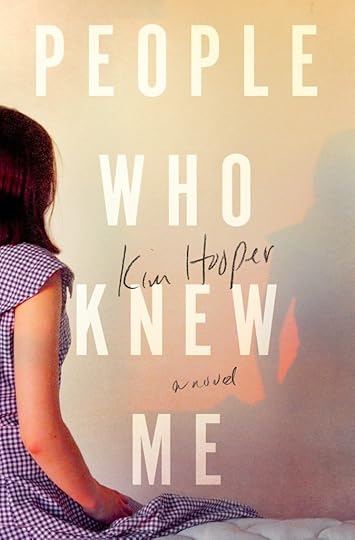
This, more than anything, makes it all seem real–for me, and for my friends and family, too. I’ve been talking about my book for a long time, but it wasn’t until I posted the cover on Facebook that people said, “Oh, you wrote a book book!” Ha.
Something else that makes it all seem real: A couple weeks ago, I got an email from Amazon recommending my own book to me. That was a trip.
Other exciting updates:
They are going to make an audio version of PEOPLE WHO KNEW ME–yay!
The Frankfurt Book Fair is coming up in October and that’s a big venue for selling foreign rights
We’re starting to reach out to people about film rights
In the meantime, I’m 250-ish pages into writing a new novel. I’m having the familiar doubts and insecurities about it, but I’m trying to just keep going. I know it will change so much over time, so may as well get a first draft down. Wish me luck!
The post Publishing Journey: I have a cover (and other exciting updates) appeared first on Fiction Writing Blog.

